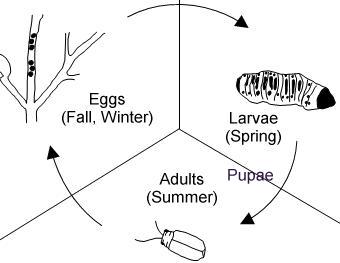Viburnum leaf
beetle home
How to ID
viburnum leaf
beetles
Timeline - What to look for through the year
Logo images by Kent Loeffler, Paul Weston & Craig Cramer
|
Lifecycle summary: Viburnum leaf beetles only infest viburnums. They complete just one lifecycle each year. Adult females lay up to 500 eggs on viburnum twigs in summer and early fall. The eggs overwinter and hatch in spring. Larvae feed on foliage until early summer, then crawl down the shrub and pupate in the soil. Adults emerge from the soil in midsummer, feed again on viburnum foliage, and mate. From egg hatch to adult takes just 8 to 10 weeks.

Click to open larger image in new window.
Lifecycle details: Adult females begin laying eggs in late June to mid-July and continue laying eggs as late as October, until the first killing frost. They prepare laying sites by chewing small holes (about 1 mm in diameter, or about the size of a pinhead) into a small branch or twig. The laying sites are usually (though not always) on the current season's growth.
The females typically deposit about eight eggs (though the number may vary) into the hole and seal the hole with a lid or "cap" made of chewed bark and excrement held together by a special cement that they make. (The caps actually sponge up and store water to help keep the egg cavity humid.)
A female will continue up the twig excavating cavities and laying eggs, leaving a distinctive row of caps, usually along the underside of the branch or twig. (Pictures and more information about eggs.) Egg-laying occurs mostly at night.
The eggs overwinter in these snug little holes, and the larvae emerge from the eggs in late April or early May in response to warming temperatures. (Pictures and more information about larvae.)
We are still learning about the relationship between spring weather conditions and when the eggs hatch. You can help us to better understand this by observing viburnums with egg-laying sites often around the time larvae emerge.
The young larvae feed together (often several to a leaf) beginning on the underside of tender, young, expanding viburnum leaves. They often start with lower leaves, "skeletonzing" them -- leaving only the midrib and major veins intact. If the infestation is heavy enough, the larvae will completely defoliate the shrub.(Pictures and more information about larva damage.)
Larvae go through three instars (stages) shedding their cuticle ("skin") between each. In early to mid-June, when they reach about 10 to 11 mm long, the larvae crawl down the shrub, enter the soil, and pupate. (This is the non-feeding stage between larvae and adult where the pupae develop within a cocoon, similar to the lifecycle of butterflies.) Pupae are very hard to find. They need moist soil. If it's too wet or too dry, the pupae don't seem to survive as well. (Pictures and more information about pupae.)
In early July, the adult beetles emerge from the soil and start feeding on viburnum foliage. They continue to feed, mate and lay eggs until the first killing frost. This is the stage where they may migrate to other plants that haven't yet been infested. (Pictures and more information about adults and adult damage.)
What is the viburnum leaf beetle's geographic range?
- They are native to and found throughout most of Europe.
- In Canada, they are currently found in many areas of Ontario and the Canadian Maritime Provinces. They're recently been discovered in British Columbia.
- In the United States, they have been reported in parts of New York State, Maine, Pennsylvania, Vermont, and parts of Ohio.
- Distribution maps:
To learn more about the viburnum leaf beetles:
© Copyright, Department of Horticulture, Cornell University.
Project coordinator: Lori Brewer, ljb7@cornell.edu
Website design: Craig Cramer cdc25@cornell.edu
Mention of trade names and commercial products is for educational purposes; no discrimination is intended and no endorsement by Cornell Cooperative Extension or Cornell University is implied. Pesticide recommendations are for informational purposes only and manufacturers' recommendations change. Read the manufacturers' instructions carefully before use. Cornell Cooperative Extension and Cornell University assumes no responsibility for the use of any pesticide or chemicals. Some of the links provided are not maintained by Cornell Cooperative Extension and Cornell University. Cornell Cooperative Extension and Cornell University are not responsible for information on these websites. They are included for information purposes only and no endorsement by Cornell Cooperative Extension or Cornell University is implied. Cornell Cooperative Extension provides equal program and employment opportunities.
|